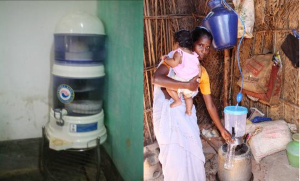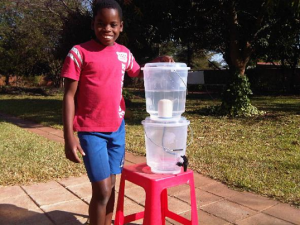 Asian Table top filter including a mineral pot
Photo left, Tulip Siphon filter  A Table top filter, Safi partly produced in Malawi
|
Description
Another option for treatment are water filters. In the last years new lower cost filters entered the market in Malawi
Advantages compared to Chlorine
- – Good quality filters do eliminate Cryptosporidium.
- – Filters do not give a taste or smell like chlorine so people like it better
- – In general the consistence of use of filters is much higher than Chlorine. Once people are used to take water from a filter they will do that daily.
Disadvantages compared to Chlorine
- – High upfront cost
- – Not yet available everywhere, since it is still new, the supply chain needs to develop more
- – The Siphon model is more complicated than the Table top model so needs more training in maintenance
Information
- Filters remove germs in a mechanical way, no chemicals or additives are used
- Filters like Safi model and Tulip siphon filters comply with the WHO standards for Bacteria and Protozoa (removal 99.995%)
- Filter elements last for 1 to 1.5 years , after that they need replacement
- Table top filters like the Asian model have a filer capacity of 25 -30 litres. The Safi filter is 50 Litres per day. The siphon model is 100 litres per day
- Cost; Safi filter ca 18 US$. Filter elements ca 7 US$
- Cost; Asian Filters 40 – 100 US$
- Producers. Info at all SMART Centres
|